Suillus spraguei
Suillus spraguei is a species of fungi in the family Suillaceae. It is known by a variety of common names, including the painted slipperycap, the painted suillus or the red and yellow suillus. Suillus spraguei has had a complex taxonomical history, and is also frequently referred to as Suillus pictus in the literature. The readily identifiable fruit bodies have caps that are dark red when fresh, dry to the touch, and covered with mats of hairs and scales that are separated by yellow cracks. On the underside of the cap are small, yellow, angular pores that become brownish as the mushroom ages. The stalk bears a grayish cottony ring, and is typically covered with soft hairs or scales.
| Suillus spraguei | |
|---|---|
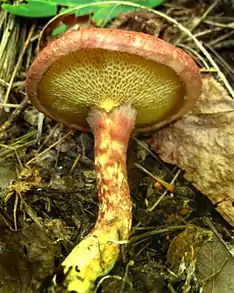 | |
| Found in New Hampshire, US | |
| Scientific classification | |
| Kingdom: | |
| Division: | |
| Class: | |
| Order: | |
| Family: | |
| Genus: | |
| Species: | S. spraguei |
| Binomial name | |
| Suillus spraguei | |
| Synonyms[1] | |
| Suillus spraguei | |
|---|---|
float | |
| pores on hymenium | |
| cap is convex | |
| hymenium is decurrent | |
| stipe has a ring | |
| spore print is olive-brown | |
| ecology is mycorrhizal | |
| edibility: choice or edible | |
Suillus spraguei grows in a mycorrhizal association with several pine species, particularly eastern white pine, and the fruit bodies grow on the ground, appearing from early summer to autumn. It has a disjunct distribution, and is found in eastern Asia, northeastern North America, and Mexico throughout the range of the host tree. The mushroom is edible; opinions about its quality vary. The mushroom bears a resemblance to several other Suillus species, including the closely related S. decipiens; the species can be differentiated by variations in color and size.
Taxonomy, phylogeny, and naming
Suillus spraguei has had a complex taxonomic history. The first specimen was originally collected in New England in 1856 by Charles James Sprague, and a formal scientific description was published in 1872 when Miles Joseph Berkeley and Moses Ashley Curtis called it Boletus spraguei. In a publication that appeared the following year, American mycologist Charles Horton Peck named the species Boletus pictus. Berkeley and Curtis had also described what they believed to be a new species—Boletus murraii—although this was later considered by Rolf Singer to be merely a younger version of their Boletus spraguei.[6] Peck's description appeared in print in 1873, but the date stamp on the original publication revealed that he had sent his documents to the printer before the appearance of the 1872 Berkeley and Curtis publication, thus establishing nomenclatural priority under the rules of fungal naming.[7] In 1945 Singer reported that the name Boletus pictus was illegitimate because it was a homonym, already being used for a polypore mushroom described by Carl Friedrich Schultz in 1806.[6][nb 1] The name was officially switched to Suillus spraguei in 1986 (Otto Kuntze had previously transferred the taxon to Suillus in 1898).[1][nb 2]
| |||||||||||||||||||||||||||||||||||||||||||||||||||||||||
| Phylogeny and relationships of S. spraguei and related species based on ITS sequences[12] |
A 1996 molecular analysis of 38 Suillus species used the sequences of their internal transcribed spacers to infer phylogenetic relationships and clarify the taxonomy of the genus. The results indicate that S. spraguei is most closely related to S. decipiens. The species S. granulatus and S. placidus lie on a branch sister to that containing S. spraguei.[12] These results were corroborated and extended in later publications that assessed the relationships between Asian and eastern North American isolates of various Suillus, including S. spraguei. The analysis supported the hypothesis that Chinese and U.S. S. spraguei and S. decipiens were each other's closest relatives, and the clade that contained them could be divided into four distinct subgroups: S. decipiens, U.S. S. spraguei, China (Yunnan) S. spraguei, and China (Jilin) S. spraguei.[13][14]
The specific epithet spraguei is an homage to the collector Sprague, while pictus means "painted" or "colored".[15] Suillus spraguei is commonly known as the "painted slipperycap",[16] the "painted suillus", or the "red and yellow suillus".[17] It is also called the "eastern painted Suillus" to contrast with the "western painted Suillus" (Suillus lakei).[18]
Description

The cap of the fruit body is 3 to 12 cm (1.2 to 4.7 in) in diameter, and depending on its age, is either conic to convex, to somewhat flattened at maturity. The cap margin is initially rolled downward before straightening out, often with hanging remnants of partial veil (appendiculate).[19] The cap surface is covered with densely matted filaments that are rough and scale-like. The scales are pink to brownish red, fading to a pale brown-gray or dull yellow in maturity. Under the scales, the cap surface is yellow to pale yellow-orange. While many other Suillus species have a sticky or slimy cap, S. spraguei is dry. The flesh is yellow.[20]
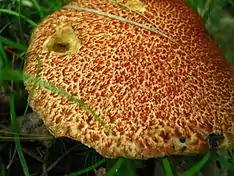
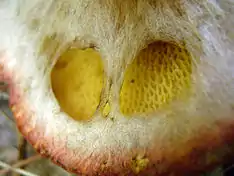
The pores on the underside of the cap are yellowish and angular, measuring 0.5 to 5 mm (0.02 to 0.20 in) wide, and formed by tubes that extend 4 to 8 mm (0.2 to 0.3 in) deep.[19] These pores have a slightly decurrent attachment to the stem (extending down its length). Young specimens have a whitish fibrous partial veil that protects the developing pores; as the cap expands it rips the veil, which remains as a grayish ring on the stem. The stem is 4 to 12 cm (1.6 to 4.7 in) long, and 1 to 2.5 cm (0.4 to 1.0 in) thick, roughly cylindrical in shape, or sometimes with a bulbous bottom so as to be somewhat club-shaped.[19][20] The stem surface is tomentose, with scales at the top, and a ring on the upper half of the stem. Below the ring the stem is fibrillose, covered with a mat of soft hairs. Its color at the top is yellow, but with wine-red to reddish-brown scales below, underlaid with a pale yellow to grayish color.[20] The stem is usually solid, rarely hollow.[16] The tissue of all parts of the fruit body—cap, pores, and stem—will turn brownish shortly after being bruised or injured.[17][20]
In deposit, such as with a spore print, the spores of S. spraguei appear olive-brown in color;[21] this changes to clay or tawny-olive after drying.[22] Microscopically, the spores have smooth surfaces, measuring 9–11 by 3–4.5 µm; in side profile they have asymmetrical sides and a suprahilar depression (a surface indentation formed where the spore attaches to the basidia), while in face view they appear oblong. The spores are not amyloid, meaning that they do not absorb iodine when stained with Melzer's reagent.[23] The basidia (the spore-bearing cells in the hymenium) are thin-walled, four-spored, and have dimensions of 17–19 by 5–7.8 µm. In the presence of potassium hydroxide, they appear hyaline (translucent), and they become pale yellow to nearly hyaline in Melzer's reagent.[1]
Various parts of the mushroom display characteristic color reactions to chemical tests commonly used in mushroom identification. The cap cuticle will turn a blackish color with the application of a drop of potassium hydroxide (KOH), iron sulfate (FeSO4) solution, or ammonia solution. The mushroom flesh turns grayish-green to greenish black with a drop of FeSO4, and olive to greenish black with KOH or NH4OH.[19]
Edibility
Suillus spraguei is an edible mushroom.[23] Its taste is not distinctive, and the odor has been described as "slightly fruity".[20] It turns a blackish color when cooked,[21] and some consider it choice,[15] and "among the better edibles in the genus Suillus".[21] In contrast, another source on mushrooms of Québec described the mushroom as a poor edible ("comestible médiocre"), and warned of a slightly acidic taste and disagreeable flavor.[24] Michael Kuo's 2007 book 100 Edible Mushrooms rates the taste as mediocre, suggesting "its sluglike consistency has all the palatability of unflavored gelatin." The book recommends frying the thinly sliced mushroom in butter or oil until it acquires a crispy texture.[18]
Similar species
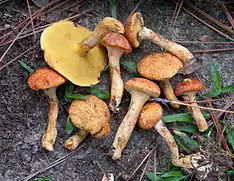
S. spraguei is a popular edible among novice mushroom hunters as it is readily identifiable due to both its appearance and its association with white pine. This renders it unlikely to be confused with other species,[17] but it shares similar characteristics with several other Suillus species. S. spraguei bears some resemblance to the rosy larch bolete (S. ochraceoroseus),[25] but the latter species has a darker spore print, a thicker stem, and grows in association with larch.[26] S. cavipes, another associate of larch trees, is more brownish and has a hollow stalk.[27] S. lakei is less brightly colored than S. spraguei, has a shorter stalk, and usually grows with Douglas fir.[28] S. decipiens has a less intensely red cap when young, but the color of older specimens fade and can resemble S. spraguei. S. decipiens generally has a smaller stature, with a cap ranging from 4 to 7 cm (1.6 to 2.8 in) in diameter, and stem that is typically 4–7 cm (1.6–2.8 in) long by 0.7–1.6 cm (0.3–0.6 in) thick. Further, its pores are irregular in shape, measuring 0.5–1 mm in diameter at maturity, and stain a shade of hazel rather than reddish to brownish. It is found in the southeastern United States, from New Jersey south to Florida and west to Texas.[29]
Ecology, habitat and distribution
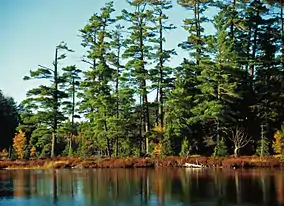
In nature, Suillus spraguei forms ectomycorrhizal relationships with five-needled pine species.[30] This is a mutually beneficial relationship where the hyphae of the fungus grow around the roots of the trees, enabling the fungus to receive moisture, protection and nutritive byproducts of the tree, and affording the tree greater access to soil nutrients. S. spraguei produces tuberculate ectomycorrhizae (covered with wart-like projections) that are described as aggregates of ectomycorrhizal roots encased in a fungal rind, and rhizomorphs that are tubular fungal cords with a hard outer sheath.[30] The fungus has ecological host specificity, and in natural soils can only associate with white pine, a grouping of trees classified in subgenus Strobus of the genus Pinus.[31] Under controlled pure culture conditions in the laboratory, S. spraguei has also been shown to form associations with red pine, pitch pine, and loblolly pine.[32] Asian populations have been associated with Korean pine, Chinese white pine,[13] Siberian dwarf pine and Japanese white pine.[33] In North America, fruit bodies appear earlier than most other boletes, as early as June (bolete fruit bodies generally begin to appear in July–September),[34] but they may be found as late as October.[17] Mushrooms can be parasitized by the fungus Hypomyces completus. In the asexual stage of H. completus, it appears initially as patches of whitish mold on the surface of the cap or stem that rapidly spread to cover the entire mushroom surface and produce conidia (asexual spores). In the sexual stage, the mold changes color, progressing from yellow-brown to brown, greenish-brown and eventually black as it makes perithecia, asci-containing sexual structures that produce ascospores. The perithecia are pimply and give the surface a roughened texture.[35]
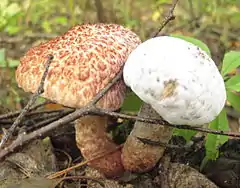
A Japanese field study found that S. spraguei was the dominant fungus in a 21-year-old stand of Korean pine, both in terms of ectomycorrhizae (measured as percentage of biomass present in soil samples) and by fruit body production (comprising over 90% of dry weight of total fruit bodies collected of all species). The production of S. spraguei fruit bodies averaged about one per square meter, without much variance during the four-year study period. The mushrooms appeared mostly from August to November, tended to grow in clumps, and the spatial distribution of clumps was random—the location of the clumps was not correlatable with appearances in previous years. The density of mushrooms along a forest road was higher than average, suggesting a preference for disturbed habitat.[36] The results also suggested that S. spraguei prefers to produce fruit bodies in areas with low litter accumulation, a finding corroborated in a later publication. This study also determined that the fungus propagates mainly by vegetative growth (extension of underground mycelia), rather than by colonization of spores.[37]
Suillus spraguei has a disjunct distribution[38] and is known from several localities in Asia, including China,[39] Japan,[40] Korea,[41] and Taiwan.[42] In North America, its range extends from eastern Canada (Nova Scotia)[20] south to the Carolinas, and west to Minnesota.[19] It has also been collected in Mexico (Coahuila and Durango).[38] Furthermore, the species has been introduced to Europe (Germany, Lower Saxony; Netherlands).[43][44][45][46]
See also
Notes
- According to Streinz (1862), Boletus pictus Schultz is probably the same species as Polyporus perennis (L.) Fr.,[1] currently known as Coltricia perennis.[8]
- Palm and Stewart consider Kuntze responsible for the transfer to Suillus; other authorities, including the taxonomic databases Index Fungorum[9] and MycoBank,[10] instead cite Smith and Thiers' 1964 monograph on North American species of Suillus.[11]
References
- Palm ME, Stewart EL (1986). "Typification and nomenclature of selected Suillus species". Mycologia. 78 (3): 325–33. doi:10.2307/3793035. JSTOR 3793035.
- Berkeley MJ. (1872). "Notices of North American fungi". Grevillea. 1 (3): 35.
- Peck CH. (1873). "Report of the Botanist (1869)". Annual Report on the New York State Museum of Natural History. 23: 128.
- Kuntze O. (1898). Revisio Genera Plantarum (in German). 3. Leipzig, Germany: Arthur Felix. p. 535.
- "Boletinus pictus (A.H. Sm. & Thiers) Lj.N. Vassiljeva 1978". MycoBank. International Mycological Association. Retrieved 2010-12-04.
- Singer R. (1945). "The Boletineae of Florida with notes on extralimital species II. The Boletaceae (Gyroporoideae)". Farlowia. 2: 223–303.
- Snell WH. (1945). "Notes on Boletes. VII". Mycologia. 37 (3): 374–88. doi:10.1080/00275514.1945.12023998. JSTOR 3754872.
- "Polyporus perennis (L.) Fr. 1821" (International Mycological Association). MycoBank. Retrieved 2010-12-27.
- "Suillus pictus (Peck) A.H. Sm. & Thiers". Index Fungorum. CAB International. Retrieved 2010-12-29.
- "Suillus pictus A.H. Sm. & Thiers 1964". MycoBank. International Mycological Association. Retrieved 2010-12-29.
- Smith AH, Thiers HD (1964). A Contribution Toward a Monograph of North American Species of Suillus (Boletaceae). p. 31.
- Kretzer A, Li Y, Szaro T, Bruns TD (1996). "Internal transcribed spacer sequences from 38 recognized species of Suillus sensu lato: Phylogenetic and taxonomic implications". Mycologia. 88 (5): 776–85. doi:10.2307/3760972. JSTOR 3760972.
- Wu Q, Mueller GM, Lutzoni FM, Huang Y, Guo S (2000). "Phylogenetic and biogeographical relationships of eastern Asia and eastern North American disjunct Suillus species (fungi) as inferred from nuclear ribosomal RNA ITS sequences". Molecular Phylogenetics and Evolution. 17 (1): 37–47. doi:10.1006/mpev.2000.0812. PMID 11020303.
- Mueller GM, Wu Q-X, Huang Y-Q, Guo S-Y, Aldana-Gomez R, Vilgalys R (2001). "Assessing biogeographic relationships between North American and Chinese macrofungi". Journal of Biogeography. 28 (2): 271–81. doi:10.1046/j.1365-2699.2001.00540.x. JSTOR 2656103.
- Weber NS, Smith AH (1980). The Mushroom Hunter's Field Guide. Ann Arbor, Michigan: University of Michigan Press. p. 95. ISBN 0-472-85610-3.
- McKnight VB, McKnight KH (1987). A Field Guide to Mushrooms, North America. Boston, Massachusetts: Houghton Mifflin. p. 118, Plate 11. ISBN 0-395-91090-0.
- Russell B. (2006). Field Guide to Wild Mushrooms of Pennsylvania and the Mid-Atlantic. Pennsylvania State University Press. p. 122. ISBN 978-0-271-02891-0.
- Kuo M. (2007). 100 Edible Mushrooms. Ann Arbor, Michigan: The University of Michigan Press. pp. 223–25. ISBN 978-0-472-03126-9.
- Bessette et al. (2001), pp. 246–47.
- Grund DW, Harrison AK (1976). Nova Scotian Boletes. Lehre, Germany: J. Cramer. pp. 162–63. ISBN 3-7682-1062-6.
- Roody WC. (2003). Mushrooms of West Virginia and the Central Appalachians. Lexington, Kentucky: University Press of Kentucky. p. 288. ISBN 0-8131-9039-8.
- Healy RA, Huffman DR, Tiffany LH, Knaphaus G (2008). Mushrooms and Other Fungi of the Midcontinental United States (Bur Oak Guide). Iowa City, Iowa: University of Iowa Press. p. 173. ISBN 978-1-58729-627-7.
- Miller HR, Miller OK (2006). North American Mushrooms: a Field Guide to Edible and Inedible Fungi. Guilford, Connecticut: Falcon Guide. p. 359. ISBN 0-7627-3109-5.
- Lamoureux Y. (2005). Connaître, cueillir et cuisiner les champignons sauvages du Québec [Know, Gather and Cook Wild Mushrooms of Quebec] (in French). Montréal, Canada: Éditions Fides. p. 134. ISBN 978-2-7621-2617-4.
- Given in the source as Fuscoboletinus ochraceoroseus, but this species has since been transferred to the genus Suillus. See Suillus ochraceoroseus at Index Fungorum.
- Arora D. (1986). Mushrooms Demystified: A Comprehensive Guide to the Fleshy Fungi. Berkeley, California: Ten Speed Press. p. 507. ISBN 0-89815-169-4.
- Bessette et al. (2001), p. 233.
- Bessette et al. (2001), pp. 242–43.
- Bessette et al. (2001), p. 234.
- Randall BL, Grand FL (1986). "Morphology and possible mycobiont (Suillus pictus) of a tuberculate ectomycorrhiza on Pinus strobus". Canadian Journal of Botany. 64 (10): 2182–91. doi:10.1139/b86-290.
- Hirose D, Shirouzu T, Tokumasu S (2010). "Host range and potential distribution of ectomycorrhizal basidiomycete Suillus pictus in Japan". Fungal Ecology. 3 (3): 255–60. doi:10.1016/j.funeco.2009.11.001.
- Palm ME, Stewart EL (1984). "In vitro synthesis of mycorrhizae between presumed specific and nonspecific Pinus + Suillus combinations". Mycologia. 76 (4): 579–600. doi:10.2307/3793215. JSTOR 3793215.
- Hirose D, Tokumasu S (2007). "Microsatellite loci from the ectomycorrhizal basidiomycete Suillus pictus associated with the genus Pinus subgenus Strobus". Molecular Ecology Notes. 7 (5): 854–56. doi:10.1111/j.1471-8286.2007.01727.x.
- Bessette et al. (2001).
- Rogerson CT, Samuels GJ (1989). "Boleticolous species of Hypomyces". Mycologia. 81 (3): 413–32. doi:10.2307/3760079. JSTOR 3760079.
- Kikuchi J, Futai K (2003). "Spatial distribution of sporocarps and the biomass of ectomycorrhizas of Suillus pictus in a Korean pine (Pinus koraiensis) stand". Journal of Forestry Research. 8 (1): 17–25. doi:10.1007/s103100300002. S2CID 27649536.
- Hirose D, Kikuchi J, Kanzaki N, Futai K (2004). "Genet distribution of sporocarps and ectomycorrhizas of Suillus pictus in a Japanese White Pine plantation". New Phytologist. 164 (3): 527–41. doi:10.1111/j.1469-8137.2004.01188.x. JSTOR 1514761.
- Wu Q, Mueller GM (1998). "Suillus spraguei (Berk. & Curt.) Kuntze – An eastern North American-eastern Asian disjunct bolete". Comparative Studies on the Macrofungi of China and Eastern North America. The Field Museum. Retrieved 2009-10-02.
- Chiu WF. (1948). "The boletes of Yunnan". Mycologia. 40 (2): 199–231. doi:10.2307/3755085. JSTOR 3755085. Archived from the original on 2015-09-23. Retrieved 2010-12-27.
- Murata Y. (1976). "The boletes of Hokkaido I. Suillus Micheli ex S. F. Gray m. Snell". Transactions of the Mycological Society of Japan. 17: 149–58.
- Lee C-H, Koh D-S (1993). "Morphology of ectomycorrhizae of Pinus rigida X P. taeda seedlings inoculated with Pisolithus tinctorius, Rhizopogon spp. and Suillus pictus". Journal of Korean Forestry Society (in Korean). 82 (4): 319–27. ISSN 0445-4650.
- Yeh K-W, Chen Z-C (1980). "The boletes of Taiwan (I)" (PDF). Taiwania. 25 (1): 166–84. Archived from the original (PDF) on 2011-07-18.
- Bas C. (1973). "Boletinus pictus, ein amerikanischer Röhrling im Nordwesten Deutschlands gefunden" (PDF). Westfälische Pilzbriefe (in German). 9 (3–5): 45–50.
- Schreiner J. (2012). "Der Weinrote Schuppenröhrling Suillus pictus – ein Neomycet in Niedersachsen". Der Tintling (in German). 17 (3): 13–19. ISSN 1430-595X.
- Dieker JFM. (2007). "Suillus pictus, een fraaie en opvallende nieuwe boleet voor Nederland" (PDF). Coolia (in Dutch). 50 (2): 94. ISSN 0929-7839.
- Arnolds E, Chrispijn R (2011). Paddenstoelen in Nationaal Park Het Drents-Friese Wold 2008–2010. Rapport Paddenstoelen Werkgroep Drenthe (PDF) (in Dutch). Beilen: Paddenstoelen Werkgroep Drenthe. p. 59.
Cited text
- Bessette AE, Roody WC, Bessette AR (2000). Boletes of North America. Syracuse, New York: Syracuse University Press. ISBN 978-0-8156-0588-1.
